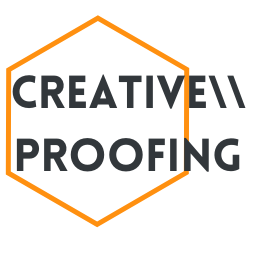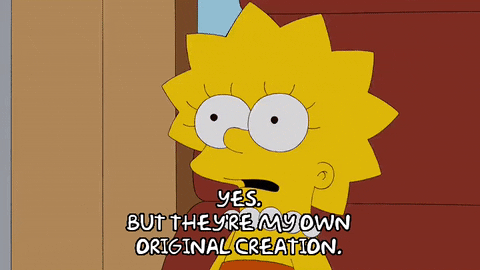I'm Megan J. Robinson, and this is Creative\\Proofing, a space to think, feel, and design out loud. Every Thursday I'll send you a newsletter exploring the intersection of creativity, spirituality, and productivity, and what that looks like for each of us. In each issue of Creative\\Proofing, I’ll dig into various questions, ideas, and topics by sharing what other thinkers, feelers, and doers have said, followed by my take, and then, what it do and what it mean for us going forward. I’ll also try to throw in reader feedback, recommendations, and maybe something I’m enjoying that week. Stick around to find out more, hmmm?
This newsletter is currently ad-free, and just free. (If that changes in the future, I'll be sure to let you know.) You can reach me anytime by replying to this email, and if someone sent this to you, they may be asking you to sign up as well. You can do that by clicking here.
If you'd like to listen, you can also subscribe to the Creative\\Proofing podcast.
What comes to mind when you think of creativity? Or imagination?
Do you go to music, and painting, and poetry, and other "artsy" activities? Do you think of the mad genius scribbling furiously on a wall or napkin at random hours? Perhaps a sensitive person with soulful eyes who quotes dead poets at the drop of a hat. Or maybe you've worked in corporate or tech, where creativity has become the buzz word for becoming the next Apple, Google, Steve Jobs, or Elon Musk. Creativity and imagination usually mean something not ordinary, not normal, not you.
I know - I'm drawing caricatures of stereotypes. Yet it's not too much of a stretch to say that we've become accustomed to thinking of creativity (and creative people) as bohemian outsiders always listening to a melody no one else can hear. Human history is littered with those big, bold, radically different, boundary-pushing, transformative instances - when a sudden leap forward shifts paradigms and changes lives. But...is that the whole story? Do bohemian outsiders have a lock on creativity? Or is it possible that creativity is a lot more common - and accessible - than we think?
Let's explore.
What Others Say
What we know as an emphasis on creativity and originality expressed predominantly through art is relatively new: prior to the Enlightenment (1685-1815) and Romantic (~1800-1850) eras, producing "art" was seen more as a tradecraft. As with any craft, artworks came about through traditions and techniques passed down through families, studios, and guilds, rather than inspired individuals generating random pieces. The Western image of a lonely soul suffering and angsting for Art came about through cultural and philosophical shifts in the Romantic era, which reacted to the Enlightenment's focus on rational reason and order by holding up the senses and our emotions as equally valid means of understanding and navigating reality. This perception of creativity lends itself to the idea that creative inspiration comes from "out there" and must be passively received or emotionally experienced before we can make anything.
Linked closely to creativity is the faculty of imagination. Where creativity seems to evoke some envy, imagination sometimes evokes scorn: she "lives in her imagination and fantasies" and never notices the "real world." Confusing imagination with imaginary can imply a rejection of reality and the concrete world, but what if imagination is the very thing that connects us to the world? Philosophers Immanuel Kant and David Hume suggested that human beings engage in imaginative acts all the time, merely in the process of perceiving and navigating the world. It takes an act of imagination to connect our multiple and disconnected sense perceptions into a cohesive whole so that we can understand our experiences of the reality around us. In that case, imagination is literally the 'ground zero' of our entire mental functions and processes: without this active ordering of our experiences into meaningful structures, the world would be chaotic and unshareable. Though we aren't consciously aware of it, we share our imaginative work with one another every time we describe our experience of life, the universe, and everything.
Recent studies in cognitive science seem to support this idea of imagination, and by extension, creativity, as ways of comprehending and sharing our experience of the world. Margaret Boden describes creativity as "the ability to come up with ideas that are new, surprising, and valuable," whether a concept or theory, an algorithm, an engineering design, a poem, a style of music or dancing, or a cooking recipe. As this list suggests, creativity manifests in every area of human intelligence and life. What we're used to thinking of as Creativity! Boden calls "H-creativity" - those historically radical, big, visible ideas that cause paradigm shifts and transformational work. But, Boden notes, any and all such expressions are rooted "P-creativity" (personal or psychological creativity) which enables each of us to engage exploratory or combinational creativity, connecting new and old ideas in fresh ways.
Bernard Roth (mechanical engineer, educator, and founder of Stanford's D.School) observed that "all persons of normal intelligence possess some ability to think creatively and to engage themselves in imaginative and innovative efforts." If it hasn't become clear by now, there's a case to be made for each one of us to flex our imaginative and creative muscles in some way in our lives. So why don't we? Unfortunately, as Roth goes on to say, "the average person's creative ability has been steadily diminished since childhood; this is a result of the societal pressures against individuality and lack of exercise of the creative faculties in daily life." When we're surprised by a creative idea, it's usually because we're asked to contrast the unfamiliar idea with the specific cultural knowledge that we've been exposed to and already understand. We then have to choose to accept or reject that new idea. If our existing knowledge hasn't prepared us to interact or experiment with a variety of unfamiliar ideas, or if we were somehow "called out" negatively whenever we did, then, our ability to "exercise our creative faculties" can atrophy, leading us to believe that creativity belongs to a select few, rather than everyone.
Again, Boden suggests that exposure to, and playing with, a diversity of concepts, ideas, structures, and vocabularies is a great place to start, along with giving yourself space to explore without judgement. The more ideas you interact with, the greater your capacity will be to sift through various combinations, compare and contrast results, and articulate what's different, interesting, and new (and the more your self-confidence will grow). Granted, this is just the beginning (and we've only scratched the surface) but, just like the Von Trapp kids learned, that's a pretty good place to start.
Here's an insight from actor Ethan Hawke. He asks, "What do you love?"
Each one of us has that thing that makes us nervous, excited, intrigued, and yes, creative. It's that thing that we find time for in stolen moments and half-formed practices during our everyday lives. But, as he points out, echoing Roth's observation, "the pull of habit is so huge" - our everyday lives have accumulated practices and routines that make us feel as though we can never give full attention and energy to those stolen, half-formed loves. But that doesn't have to be the end of the story.
Hawke goes on to say that "when you get close to what you love, who you are is revealed to you, and it expands. [...] When you start to express yourself, you start to know yourself. You just have to follow your love. [...] There is no path, you have to be willing to walk and play the fool."
What I Say
As I've mentioned before, my entire life has pretty much been a solo competition for World's Most Creative Ever. I don't know how not to be creative. That said, exercising that creativity takes work: a willingness to be surprised, to challenge assumptions, to trust what I've learned so far, and to try every day to add more back into the world than I've received from it. I've had to learn to "play the fool" my entire life, and there are many moments when I've wanted to walk the well-made paths to money, comfort, and stability by setting aside the surprising, the unfamiliar, and the uncomfortable. Exploring and expressing my creativity has often meant a conscious evaluation and re-commitment to surprise, challenge, foolishness, and generosity, and what those look like in my life.
The more I study creativity and imagination, the more I think that they rely on building the skill of discernment, seeing "beyond" or "beneath" the surface of things. We must pay attention, increase our capacity to articulate what we encounter, and how it connects with our lives. Creativity can become a posture of relating to the world, an approach to seeing and engaging with our lives that can be transformational: What's possible? How can I create something of my life that didn't exist yesterday? Whether trying a new flavor combination, practicing a chord shift, or kickstarting the next paradigm change, I am convinced that being creative is as simple as answering the question What new thing is possible that doesn't yet exist? one day at a time.
What's Next?
If you're feeling inspired or courageous, and want to flex your creative muscles again, hooray! Now what? You may wonder what creativity looks like for you, or you may feel awkward in trying to figure out a creative outlet, especially if it's been awhile.
Take a deep breath, let it out, relax. Keep it simple.
Start by paying attention: notice what happens when you walk out your front door, what do you see? feel? smell? hear? What makes you catch your breath in suprise? What makes you do a little happy dance inside?
At least once a week, make a note of what caught your attention (and by note, I mean a voice memo, a napkin doodle, a recipe idea, a soldering technique (are there different techniques?) - you get the picture). Productivity expert Tiago Forteinsists that you can't do anything unless you make a note: pull it down from your mind and make it visible and concrete somehow. (Kinda like Dumbledore's Pensieve, but less wispy.) Once you have your note, whatever that looks like, you begin to build a library of ideas that you can sort through, pull out, hold up to the world, and then, make something that never before existed until just now.
Let me know how it goes for you.
Creative\\Responses
Got a question, feedback, or something to share? All you have to do is reply to this email and write me! (Be sure to let me know if you want to remain anonymous, or if it's ok to use your first name.)
Creative\\Recommendation
Speaking of generating new possibilities: check out the Netflix series Abstract: The Art of Design, especially the very first episode with illustrator Christoph Niemann.
Creative\\Enjoyment
Dude: limited edition chocolate donuts from Duck Donuts. If you don't have one near you, well. I don't know what to say.
Tell your friends.
If you’d like to support Creative\\Proofing, the best thing to do is spread the word. If you think of five friends who might enjoy this, forward this email to them! Degrees of gratitude may vary, but please know, my gratitude is infinite.
You can share Creative\\Proofing on all the socials. You can also follow on Instagram @R21.5Coaching.
Shalom!





